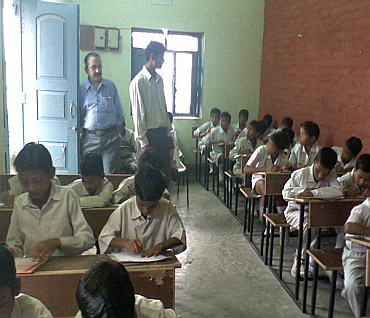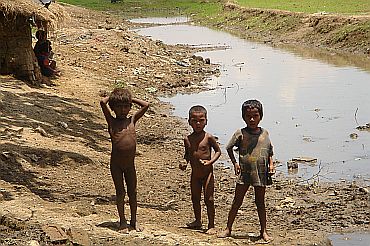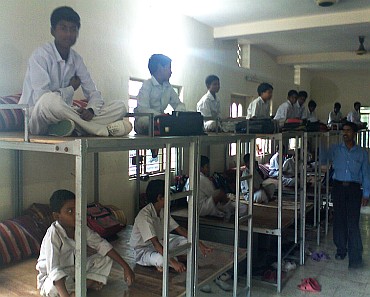
Rahul Bedi tells the story of Bihar's 'untouchable' Musahar community, which is slowly, but steadily rising to its feet, with the help of J K Sinha, a former intelligence officer and a Good Samaritan. He has built a modest residential school that offers their deprived youth not only free and competent education, but also self esteem.
In two identical buildings in Patna, the five-year-old Shoshit Samadan Kendra, or School for the Welfare of the Exploited provides board and lodging, uniforms, toiletries, books and even access to computers to close to 200 young Musahar boys absolutely free of charge.
"I was destined to raise pigs and live a life of wretchedness and exploitation. But that changed four years ago after joining SSK, which, for me has opened up a world of possibilities," said 14-year-old Pappu Kumar.
Dressed in his crisp white cotton uniform and knee-length stockings, and barely indistinguishable from students of nearby exclusive St Xavier's -- the city's oldest, Jesuit-run school -- the academically brilliant Kumar plans the unimaginable: competing alongside Bihar's higher castes to join one of the handful of Indian Institutes of Technology.
"SSK aims to bring about a palpable revolution in the Musahar community which has lived in sub-human conditions for centuries," says J K Sinha the founder, who retired in 2005 as one of India's top intelligence officers and returned home to found the Shoshit Seva Sangh that runs the school.
Pooling his life savings and with modest contributions from family and friends, Sinha set about establishing SSK to uplift the socially shunned Musahar community -- who ate infrequently, and were exploited pitilessly as bonded labourers by upper-caste landlords and mahajans (money lenders) -- through education.
Even today, the 'untouchable' Musahars (population around 4-5 million), remain confined by the upper castes to living in foul-smelling ghettoes called 'Mushairies' or 'Musahar Tolis' on the outskirts of many Bihar villages, with neither rights nor privileges.
Being 'untouchables', they were considered outcasts, outside Hinduism's rigid caste system -- an ancient hereditary class order that divides society into four general categories -- traditionally associated with unhygienic jobs.
This includes cleaning human waste, scavenging animals and at best, like the Musahars breeding pigs in soiled environments.
...

At the top of India's uncompromising caste system are the Brahmins, while the lowest, manual labourers were the Sudras. In between are the Kshatriya's, or warriors. The Vaishya's or traders fall below them, and these antiquated gradations are strictly enforced in Bihar, India's poorest and most regressive province.
Sinha, a 'high-caste' himself, however, believes it was not merely enough to give Musahar children education, but through it, to empower them to eventually become a catalyst for change within their depressed community.
According to official figures, almost all Musahars were landless labourers, and barely three per cent of them were literate. Social activists in Patna estimate that under prevailing conditions, it would take the Musahars a mind-boggling 4,419 years to achieve complete literacy.
Decades of deprivation, apartheid and money lenders too had driven many Musahars to crime. A large number their youth had also joined the proliferating Maoist movement, active across large parts of Bihar to secure economic and social justice for the state's poor and dispossessed through its 'People's War'.
The sheer hopelessness of the Musahar community was revealed over four years ago with the account of 45-year old Jawahar Manjhi's debt of Rs 5,000 which he had laboured under for 27 years.
Manjhi's initial loan in 1980 of 40 kg of rice for a family wedding from a money lender in Paliganj (barely 60 km from Patna), turned him, like thousands of fellow Musahars, into a bonded labourer on his patrons' rice fields.
At the time of securing the loan, it was agreed that for each day of work on the money lenders farm Manjhi would be paying back the equivalent of one kilogram of rice of the 40 he had borrowed, making it a total workload of less than six weeks.
But Manjhi ended up borrowing additional rice to feed himself and his family, and even after 27 years, being illiterate and disadvantaged, had no idea how much of his debt remained outstanding.
He continued toiling daily in inhuman conditions and searing hot temperatures. Occasional inquiries regarding his balance resulted either in severe beatings or starvation. Or, at times, both.
Eventually in 2006, he was told that a Rs 5,000 payment would liberate him from his bond, but this too remained far beyond his reach.
...

Bihar's exploitative money lenders are unusually usurious, levying crippling monthly interest rates of 10-20 per cent or 120-240 per cent per year, rendering debtors wholly incapable of repaying their principal sum.
This, in turn forced them much like Manjhi into a lifetime of inhuman bondage.
Women too were exploited, many of them sexually, and low caste children mostly Musahars became adults in servitude.
"Musahar children know only poverty and an aimless future, which in some small way, we aim to mitigate through SSK," elaborates Sinha who says the initial response to his proposal for a school for them was skeptical.
The Musahars were unconvinced that this suave former police officer who had lived a glamorous life, could offer them an alternative to the ramshackle, state-run rural schools they knew with no teachers or textbooks and where their persecution as 'untouchables' persisted.
But within two years their attitude changed.
In 2010 some 750 Musahar children appeared for SSKs entrance examination for 50 placements in the English medium school.
SSKs teacher student ratio of 1:17 too was significantly better than most leading private schools in addition to which the instructors were conscientious and well paid.
"By ensuring the quality of education we can change the profile of poverty in the state, in time," says Sinha.
...

"I was living in filth in a mud hut with no clothes, food or dignity," says 11-year-old Pankaj Kumar Manjhi who earlier lived on Patna's outskirts with his widowed mother who earned Rs 25 a day, but only during the crop sowing and harvesting season lasting barely six to eight months each year.
For the remaining period, the duo scoured Patna's mountainous rubbish heaps for sustenance.
"All that is behind me now in SSK," says the class VII student who aspires to become an engineer.
"I am somebody now and will become more important," he adds.
Sinha, meanwhile, who rents SSKs premises and plans to increase his annual intake of students to 55, is determined to soon build his own school for which land has been acquired but construction funds were needed.
He recently launched a campaign to raise Rs 5.5 crore from local and overseas corporate groups and non-governmental organisations, and is optimistic about achieving his goal.
"It's a meager sum to give the entire Musahars dignity and to trigger a cataclysmic change amongst them," he declares.
"It's the least we can do for them," he adds.